This site is made possible by its sponsors.
Please visit them!
Liao - A Chinese dynasty which lasted 916 - 1125.
liberal arts - The humanities — non-scientific branches of study, such as philosophy, literature, and art, that are concerned with human thought and culture.
Also see art criticism, art history, cognitive, empiricism, epistemology, knowledge, memory, metaphysics, mind, music, ontology, phenomenology, science and art, sense, and teleology.
lierne - A short rib that runs from one main rib of a vault to another.
(pr. lee-ERN)
life drawing - The act of drawing the human figure from a live (often nude) model, and each such drawing produced. Widely considered an essential component of an artist's education, life drawing trains the simultaneous workings of the eyes, the brain, and the hand; and increases skills needed for representation of the human form — arguably the most important subject in art in its long history. Life drawing should increase knowledge of the underlying structure of the human figure — from skeletal to muscle, fat, and skin — the form to which any costume must correspond. Life drawing establishes the importance of seeing the figure dynamically — in its cababilities for variety of pose and composition, action and expression. There are many ways to intensify the learning experience of life drawing. One is the practice of gesture drawing — drawing at relatively great speeds, for as long as five minutes, and as short as a few seconds. Others are continuous-line and contour drawing.
Examples:

Mike Reed (American, contemporary), Gesture
Drawing of Reclining Woman, charcoal
pencil on newsprint,
18 x 11 inches, drawn while observing a model's 5 minute pose. "I am absolutely
persuaded that almost every drawing issue
an artist will encounter can be found in the human figure,"
Mike Reed has said.

Tony DiTerlizzi (American, 1969-), Life
Drawing of a Male Model, Berol Prismacolor terra cotta
and China white pencils
on paper, 11 x 8 1/2 inches, the artist.
Visit the
artist's site.
![]()

Elizabeth Luce (American, contemporary),
Life
Drawing Female Nude, charcoal
on paper.

Matthew Henry (American, contemporary), Life Drawing
Female Model, pastel and
wash on paper.
Also see academy figure, anatomy, bone structure, and écorché.
life mask - A cast of the face of a living person. Usually such casts have been made from a mold produced by placing gesso or plaster on the face, with a passage provided for breathing through the mold. Such a mold is likely to be of one piece, since the face is generally sufficiently flexible to enable removal of the hardened mold, as long as a release agent has been applied. A death mask is very similar.
Also see mask, and a lesson on mask making using plaster bangages.
life size - Full-scale.
Examples:
Egypt, between 1991 and 1928 BCE (early 12th Dynasty), Large Statue of Nakhti, Assiout, acacia wood, 1.785 x (width of base) 49.5 x 1.10 m, Louvre.
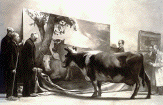
Mark Tansey (American, 1949-), The Innocent Eye Test, 1981, oil
on canvas, Metropolitan Museum
of Art, NY. Mark Tansey is known particularly for his monochromatic
paintings which are often humorous mock-historical scenes that refer to art historical subjects
and concern art criticism.
This picture depicts a group of official looking men observing
and recording a
 cow's reaction to a life-size painting of two cows. The men are
dressed in lab coats and corporate suits, and with the exception
of one man holding a mop, they are all wearing eyeglasses. The
cow is looking
at an actual painting:
cow's reaction to a life-size painting of two cows. The men are
dressed in lab coats and corporate suits, and with the exception
of one man holding a mop, they are all wearing eyeglasses. The
cow is looking
at an actual painting: Paulus
Potter (Dutch, 1625-1654), The Young Bull, 1647. See pastoral.



Cesar Martinez (Mexican, Mexico City, 1962-),
Aqui
estoy, 2001, inflatable
latex sculpture,
life size.
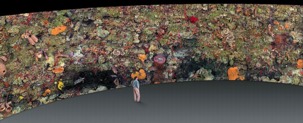
Jim Hellemn (American, contemporary), Bloody Bay
Wall, 2001, photograph, 20 x 62 feet. Bloody Bay Wall
is part of a unique ocean reef system surrounding Little Cayman
Island, a popular destination for scuba divers in the British
West Indies. You can see this photograph online at life-size
— an image of the underwater site as if you were exploring it
in real life. The scene is fully illuminated in a way that shows
the true colors of the marine life. To view the Blood Bay
Wall mural at life-size, click on the link above. Then click
on the "Zoom In" icon. The mural image will appear
in a new window. To zoom in, select the magnifying glass tool,
then click, hold and drag with the left mouse button. Drag toward
the lower part of the screen to zoom in. For more info hit the
"See it Life-size" link. The image on the web is an
24 bit RGB image 16,992 pixels high x 53,568 pixels wide. This
is life-size at typical screen resolution of 72 dpi. The full
high resolution version of the Bloody Bay Wall image is 23,010
pixels high x 72,540 pixels wide. Unfortunately, the free plug-in
with which to view the mural runs only on a Windows PC.

Celebritycutouts.com currently makes life-size
cardboard cutouts of photos
of celebrities of popular culture
— entertainers, politicians, etc. "Great for parties and
special events whether it's for school, business or personal
enjoyment."
Also see human scale and mannequin.
ligature - In calligraphy and typography, two or more letters joined together to create a single character. Among the most common such combinations: æ (a+e) and Æ (A+E). Among other letters most commonly combined include oe, fi, ff, and ffl. When cast type was employed (before the digital revolution), a ligature was cast on the same body of type. Kerning, by comparison with ligature, is the technique of adjusting the spacing between two letters to bring them close enough to overlap. Some ligatures, including "æ", might be described as made by kerning. The horizontal spaces between lines of type are called leading.
(pr. LI-gə-chər)
Example ligatures:
![]()
Also see flourish, graphic design, lacuna, leading, letterform, lettering, letter space, placement, space, text, type, and typeface.
lightfast - Having the ability to resist fading on long exposure to sunlight. Denotes permanence when applied to pigment. The opposite quality is called fugitive.
lightness - The dimension of a color which is correlated with luminance and by which visual stimuli are ordered continuously from very dim to very bright. Pure white has the maximum brightness, and pure black the minimum brightness.
Also see light.
light perception - Discrimination between light and dark. Or, between brighter and darker light.
light table - A work surface of translucent white glass or plastic with a lamp beneath it, used especially for looking at transparencies and for tracing.
likeness - A loose way of referring to what may be appropriation, comparable, copy, counterfeit, facsimile, fake, forgery, homage, imitation, mirror, positive, representation, reproduction, simulacrum, and/ or simulation.
limestone - Stone composed mainly of calcium carbonate, much of it sedimentary rock and formed by fossil deposits. Marble is actually a limestone that can be polished.
Examples of works in limestone:
Egypt, c. 2620-2350 BCE (4th or 5th Dynasty), The Seated Scribe, Sakkara, painted limestone statue, 53.7 x 44 x 35 cm, Louvre. See Egyptian art and polychrome.
Mesopotamia, Tello, formerly Girsu, around 2500 BCE, Urnanshe (King of Lagash) Relief, limestone, 0.40 x 0.47 m, Louvre. See Mesopotamian art.
![]()
Egypt, early Fifth Dynasty, The Royal Descendant Hetepheres, c. 2440
BCE,
limestone, Worcester Art Museum, MA. See Egyptian art.

China, Shenxi Provence, Seated Bhuddha with Attending Bodhisattvas,
Northern Wei dynasty, early
6th century CE,
limestone with polychrome,
Worcester Art Museum, MA. See Bodhisattva,
Buddhist art, and Chinese art.

![]()
![]()
Amedeo Modigliani (Italian, 1884-1920), Head, c. 1911-2, limestone, 63.5 x 12.5
x 35.0 cm, Tate Gallery, London. Another view. This elongated
head was inspired by African
masks and Gothic sculptures.
Henri Laurens (French, 1885-1954), Head of a Young Woman, 1920, limestone, 39.3 x 17.4 x 12.5 cm, Tate Gallery, London. See Cubism.
Also see carbon, quarry, statue, and travertine.
limit and limitation - Limitation is showing restraint, taking something only so far and then stopping before doing to much; a principle of design in contrast to horror vacui, and to emphasis or dominance.
Quotes:
Also see beauty, definition, edge, elegance, simplicity, sublime, and taste.
limited edition - An edition or set of prints of a known number of impressions, usually fewer then 200, numbered and signed.
limners - May refer to any painter, but more often to itinerant American painters of the eighteenth and early nineteenth centuries, who made literal and naïve portraits. They were largely self-taught. Also, may refer to a painter of miniatures in medieval illuminated manuscripts.
(pr. LIM-nərz)
Examples by some of the early American limners:
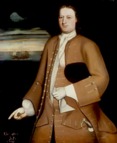
"The Schuyler Limner" (American,
active in NY, in the Albany-Schenectady area 1717-1725), Mr.
Willson, 1720, oil.
The "Schuyler Limner" could possibly be Nehemiah Partridge.
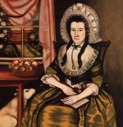
"The Beardsley Limner" (American,
active 1785-1805), Mrs. Hezekiah Beardsley, c. 1785-1790,
oil, Yale University Art Gallery,
NJ. The Beardsley Limner was an itinerant artist who executed
several naive portraits along the old Boston Post Road, in Connecticut
and Massachusetts, from about 1785 to 1805. This name is derived
from portraits this artist made of Elizabeth and Hezekiah Beardsley.
The Beardsley Limner may actually be a Connecticut pastelist
Sarah Perkins. Some stylistic similarities exist between the
two, but there are sufficient differences to raise questions
about this identification.

"The Beardsley Limner," Little
Boy in a Windsor Chair, early 19th century, oil
on canvas, 32 x 25 inches, Montclair Art Museum, NJ.

"The Denison Limner" (American,
active c.1790), Miss Denison, oil.
"The Denison Limner" is probably Joseph Steward.
Also see American Colonial art and folk art.
line - A mark with length and direction(-s). An element of art which refers to the continuous mark made on some surface by a moving point. Types of line include: vertical, horizontal, diagonal, straight or ruled, curved, bent, angular, thin, thick or wide, interrupted (dotted, dashed, broken, etc.), blurred or fuzzy, controlled, freehand, parallel, hatching, meandering, and spiraling. Often it defines a space, and may create an outline or contour, define a silhouette; create patterns, or movement, and the illusion of mass or volume. It may be two-dimensional (as with pencil on paper) three-dimensional (as with wire) or implied (the edge of a shape or form).
Examples:
Rembrandt Harmensz. van Rijn (Dutch, 1606-1669), Two Studies of a Bird of Paradise, pen and sepia ink and wash, white highlights, 0.181 x 0.155 m, Louvre. See nature.
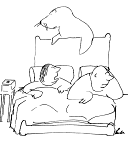
James Thurber (American, 1894-1961), All Right, Have It Your Way — You Heard a Seal Bark, c. 1937, pen and ink on paper. See contour line drawing.

Richard Long (English, 1945-), A Line Made by Walking, 1967, photograph
and pencil on board, image:
37.5 x 32.4 cm, Tate Gallery, London. Long created this earth
work by walking back and forth along the same line
in a grassy field in Somerset, England, wearing away a thin path,
which lasted until the grass grew back again. Long took this
photo of his work in order to document
it.
Quotes:
Also see align and alignment, angle, fold, linear, linear perspective, rectilineal, rectilinear, and tangent.
linear - A painting technique in which importance is placed on contours or outlines.
(LI-nee-ər)
Examples of paintings done in this manner:

Henri de Toulouse-Lautrec, The Sofa, oil
on cardboard, 24 3/4 x 31
7/8 inches (62.9 x 81 cm), Metropolitan Museum of Art, NY. See
Post-Impressionism.
Paul Klee (German, 1879-1940, born and died in Switzerland), The Mocker Mocked (Oder der verspottete Spötter), 1930, oil on canvas, 17 x 20 5/8 inches (43.2 x 52.4 cm), Museum of Modern Art, NY. See Bauhaus.
Stuart Davis (American, 1892-1964), New York-Paris no.2, 1931, oil on canvas, 30 1/4 x 40 1/4 inches, Portland Art Museum, ME. See New Deal art.
Roy Lichtenstein (American, 1923-1977), Little Big Painting, 1965, oil on canvas, 68 x 80 inches (172.7 x 203.2 cm), Whitney Museum of American Art, NY. This painting humorously toys with the idea of making the brushstroke visible: depicting a giant linear brushstroke, using the style of mass-produced cartoons. See Pop Art.
Also see labyrinth, painterly, rectilineal, rectilinear, and slip-trailing.
linear perspective -  A
system of drawing or painting
in which the artist
attempts to create the illusion
of spatial depth on a two-dimensional
surface. It works by following
consistent geometric rules for rendering objects as they appear
to the human eye. For instance, we see parallel lines as converging
in the distance, although in reality they do not. Stated another
way, the lines of buildings and other
objects in a picture are slanted
inward making them appear to extend back into space.
If lengthened these lines will meet at a point along an imaginary
horizontal line representing
the eye level. Each such imaginary line is called an orthogonal.
The point at which such lines meet is called a vanishing
point.
A
system of drawing or painting
in which the artist
attempts to create the illusion
of spatial depth on a two-dimensional
surface. It works by following
consistent geometric rules for rendering objects as they appear
to the human eye. For instance, we see parallel lines as converging
in the distance, although in reality they do not. Stated another
way, the lines of buildings and other
objects in a picture are slanted
inward making them appear to extend back into space.
If lengthened these lines will meet at a point along an imaginary
horizontal line representing
the eye level. Each such imaginary line is called an orthogonal.
The point at which such lines meet is called a vanishing
point.
The invention of linear perspective dates to the early 1400s, with Filippo Brunelleschi's experiments in perspective painting and Leon Battista Alberti's treatise on perspective theory.
Irregular applications of linear perspective have resulted in various optical illusions and anamorphosis.
Examples of pictures employing linear perspective:
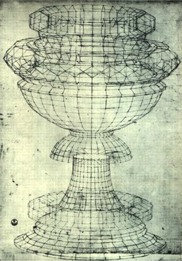
Paolo Uccello (born Paolo di Dono) (Italian,
1397-1475), Perspective
Study of a Chalice, pen
and ink on paper,
29 x 24.5 cm, Gabinetto dei Disegni, Uffizi, Florence. See Renaissance
and wireframe.

Albrecht Altdorfer (German, c. 1480-1538),
The Entrance Hall of the Regensburg Synagogue,
1519, etching,
6 1/4 x 4 3/8 inches (15.9 x 11.1 cm), Metropolitan Museum of
Art, NY. See Northern
Renaissance.
Fra Giovanni da Verona (Italian), three panels of wood intarsia, 1520: Each conveys the appearance of open cupboard doors — a trompe l'oeil effect resulting from the use of linear perspective. The first panel: a Campanus sphere, a mazzocchio, and various instruments of the geometer. The second panel: a complex polyhedron which can be constructed by erecting a pyramid of equilateral triangles on each face of an icosidodecahedron. The third: the Campanus sphere again, along with an icosahedron and a truncated icosahedron.
Hieronymus Rodler (German, d. 1539), Zu eynem Gewelb/so du off die art haben willt . . . (A vault the way you'd like it),1531, woodcut, 8 1/2 x 5 5/8 inches, from Hieronymus Rodler, Eyn schön nützlich Büchlin vnd Vnderweisung der Kunst des Messens mit dem Zirckel. Siemeren, 1531, leaf D2, Getty Research Institute, Malibu, CA. See vault.
Tommaso Laureti (Italian, 1530-1602), Design for a portion of an illusionistic ceiling, 1583, engraving, 8 3/8 x 12 5/8 inches, From Giacomo Barozzi da Vignola, Le due regole della prospettiva pratica, Rome, 1583, p. 88, Getty Research Institute, Malibu, CA.

Vincent van Gogh (Dutch, 1853-1890), A Corridor in the Asylum, late May or
June, 1889, black chalk
and gouache on pink
Ingres paper, 25 5/8 x 19 5/16 inches
(65.1 x 49.1 cm), Metropolitan Museum of Art, NY. See Post-Impressionism.

Dorothea Lange (American, 1895-1965), The Road West, 1938, depicted: United
States of America, gelatin silver print, 17.3 x 24 cm (6 13/16
x 9 7/16 inches), Metropolitan Museum of Art, NY. See photography.

Maurits Cornelis Escher (Dutch, 1898-1972),
Belvedere, 1958, lithograph,
8 1/4 x 11 5/8 inches (462 x 295 mm), National Gallery of Art,
Washington, DC. This belvedere
has three stories, but its drawing
results in an optical illusion.
Escher has employed a hybrid of linear
perspective that produces a mixture of two possibilities.
Note how the pillars connect
the second to the third story.
Robert Longo (American, contemporary), Tongue to the Heart, 1984, acrylic and oil on wood panel, cast plaster, hammered lead on wood, Durotran, and acrylic on canvas, 136 x 216 x 25 inches, Eli Broad Foundation.
Other resources concerned with linear perspective:
Also see horizon line, rectilineal, rectilinear, and wireframe.
linen - A cloth woven from thread made from fibers of the flax plant. Although it has been used in many ways, linen has been an especially desireable support for painting. As such it is one of several textiles that may be called canvas.
Examples:

Egypt, Thebes, Sheet of Royal Linen, c. 1466 BCE,
Dynasty 18, reign of Hatshepsut 6-7, linen, greatest width
63 3/8 inches (161 cm), greatest length
16 feet 11 inches (515 cm), weight
2.9 ounces (140 g), 118 warp, 77 weft
per square inches (46 warp, 30 weft per square cm), Metropolitan
Museum of Art, NY. See Egyptian
art.
![]()
Germany, Altar Cloth: Christ in Judgment and others,
second half of the 14th century, embroidery of linen
on linen, width 47 1/4 inches
(120 cm), length 13 feet (396.2
cm), Metropolitan Museum of Art, NY.
Also see textile.
linocut - Linoleum cut.
linoleum cut, linocut, or lino-cut - A linoleum block or plate used for making relief prints. Linoleum is a durable, washable material formerly used more for flooring as vinyl flooring is used today. It is usually backed with burlap or canvas, and may be purchased adhered to a wooden block. The linoleum can be cut in much the same way woodcuts are produced, however its surface is softer and without grain. Also refers to a print made with this method. Linoleum cuts have been made by Henri Matisse (French, 1869-1954) and Pablo Picasso (Spanish, 1881-1973).
Other examples:

Sybil Andrews (English, 1898-1992), Steeplechasing,
1932, linoleum cut in three colors, printed from 3 blocks in
Chinese orange, alizarin
purple madder and Prussian blue
on buff oriental laid tissue
paper, 6 x 10 3/4 inches.

Maurits Cornelis Escher (Dutch, 1898-1972),
Reflection, 1950, linoleum cut printed
from two blocks, 26 x 32 cm. Two raindrops have fallen into a
pond, and, with the concentric, expanding ripples that they cause,
disturb the still reflection
of a tree with the moon behind it. See optical
illusion and World
of Escher.
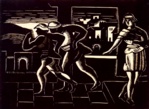
James Lescesne Wells (American, 1902-1992), Escape of the Spies from Canaan, about 1933, linoleum cut print. See African American art.

Carlos Cortez (American, 1923-), De la tierra somos !no somos ilegales!,
1984, linoleum cut in black on paper,
36 x 24 1/4 inches (91.5 x 61.6 cm), Smithsonian American Art
Museum, Washington, DC. See Chicano
art.

Carlos Cortez (American, 1923-), To Fan the Flames!, 1984, linoleum cut
in black on paper, 22 1/2 x 17 inches
(57.1 x 43.2 cm), Smithsonian American Art Museum, Washington,
DC.
![]()

Roy Lichtenstein (American, 1923-1997), the six prints in the "Bull Profile Series,"
Bull I, (the most figuratively
representational image
of the six),

![]()


![]()


and Bull
VI (the most abstract
image of the six), 1973, each
is a linoleum cut on paper, and each
is 68.5 x 89.0 cm, Tate Gallery, London. See Pop Art and profile.
Sol LeWitt (American, 1928-), Untitled, 2001, linoleum cut, 30 x 30 inches, edition of 100. See circle, conceptual art, and Minimalism.
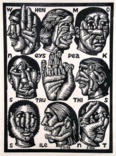
Peter Gourfain (American, 1934-), Hen Eys Tru Ile, 1993, linoleum cut on handmade paper. Peter Gourfain is fascinated by language and has developed his own alphabet (used here in his signature), and many of his works incorporate palindromes -- words or phrases that read the same backward as forward. The title of this work is culled from the apparently random vertical sorting of one column of text, which, when read in normal sequence offer the aphorism,“When money speaks truth is silent.” The four corner heads are inhabited by another sort of text: signing hands that spell out F-E-A-R.

Jonnel Covault (American, contemporary),
Catarpillar
Island, linoleum cut, 28 x 20 inches, Blackfish Gallery,
Portland, OR. See reflection.
Quote:
linseed oil - A drying oil used in paints, usually boiled to make it faster drying.
Also see marbling.
lintel - In architecture, a horizontal beam of any material spanning an opening, usually between two walls or posts.
Examples:
Egypt, 1878-1843 BCE (12th Dynasty), Lintel of Sesostris III, Medamoud Temple, limestone bas-relief, 1.065 x 2.21 m, Louvre. Although lintels are usually treated as merely functional, and often hidden, they are occasionally emphasized, as this one was. See rectangle.

France, Christ in Majesty, lintel at the church
of Saint-Génis-des-Fontaines, 1019-1020, Romanesque,
carved stone.

Emilie Benes Brzezinski (Swiss, contemporary),
Lintel, 1993, cast
bronze, 128 x 177 x 28 inches, Grounds
For Sculpture, Hamilton, NJ. Lintel was first sculpted
from cherry wood, and then cast into bronze at the Johnson Atelier
Technical Institute of Sculpture. Both post and lintel can be
seen here.
Also see frieze, lateral, post and lintel, trabeation, and tympanum.
liter - A unit of liquid measurement equal to 1000 milliliters. To convert liters into gallons (US, liquid), multiply them by 0.26417; into pints, x 2.1134. Abbreviated l.
literal qualities - The realistic presentation of subject matter in an artwork, along with the elements of art found in it; avoiding distortions, exaggerations, or embellishments. This aesthetic quality is favored by imitationalism. In describing a work, one makes an inventory of its literal qualities.
Also see aesthetics, art criticism, and art history.
litharge painting - A small amount of oil is added to paint so that it covers a surface such as a lacquered one.
living rock - Rock that is carved or in some other way used in situ. Often said of sculpture or architecture carved from rock that is so huge it could never have been moved anyway.
Examples:
Egypt, Gizeh, Old Kingdom, Great Sphinx, [another image: Pyramids and Sphinx, photo from a postcard, c.1905].
![]()
In the spring of 2000, Afghanistan's Taliban
(Islamic 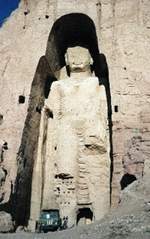 extremists in power) destroyed colossal statues of the Buddha, carved from
a living rock cliff at Bamiyan, 145 km west of Kabul, Afghanistan,
long before the arrival of Islam in that area. One of the statues
was 53 meters high and dated to the 5th century; the other was
37 metres tall and dated to the 3rd century. These were rare
examples of statuary in the Greco-Buddhist style, priceless ancient
relics of this important cultural crossroads. Several thousand
monks once lived in the caves next to the statue. The Taliban's
supreme leader, Mullah Mohammed Omar, ordered the destruction
in an edict, saying such images were contrary
extremists in power) destroyed colossal statues of the Buddha, carved from
a living rock cliff at Bamiyan, 145 km west of Kabul, Afghanistan,
long before the arrival of Islam in that area. One of the statues
was 53 meters high and dated to the 5th century; the other was
37 metres tall and dated to the 3rd century. These were rare
examples of statuary in the Greco-Buddhist style, priceless ancient
relics of this important cultural crossroads. Several thousand
monks once lived in the caves next to the statue. The Taliban's
supreme leader, Mullah Mohammed Omar, ordered the destruction
in an edict, saying such images were contrary  to
Islam. "These idols have been gods of the infidels, who
worshipped them, and these are respected even now and perhaps
maybe turned into gods again," his edict said. Other resources
on this story: 1 and 2. (See Buddhist
art, Islamic
art, vandalism, and xenophobia.)
to
Islam. "These idols have been gods of the infidels, who
worshipped them, and these are respected even now and perhaps
maybe turned into gods again," his edict said. Other resources
on this story: 1 and 2. (See Buddhist
art, Islamic
art, vandalism, and xenophobia.)
Gutson Borglum (American, 1867-1941), assisted by a workforce of 400, including hard-rock miners, ranchers, hobos, and unemployed laborers, Mount Rushmore National Monument, took 14 years, completed Oct. 31, 1941, dynamited and jackhammered pegmatitic granite, height of each face c. 60 feet, each nose 20 feet, width each eye 11 feet, the Black Hills in southwestern South Dakota. Cost nearly $1 million, 85% paid by the federal government. Visitors in 2000: 2,522,288. See monument.
Wim Delvoye (Belgian, contemporary), four
pieces:
SUE, IN BAR ROUND CORNER SEE YOU THERE. A.
MUM, KEYS ARE YOU KNOW WHERE
DAVID, JUST POPPED OUT FOR A MOMENT, BACK IN TEN MINS.
TIME TO GO. CATCH YOU LATER, A.
photographs
altered so that texts appear to have
been carved into living
rock, published in the printed and web-based art periodical TRANS>
arts.cultures.media, Vol.1/2, No.3/4, 1997. This is a
set of proposals for works in living rock.
Also see earth art, Egyptian art, monument, reserve column, sphinx, and stone.
https://inform.quest/_art